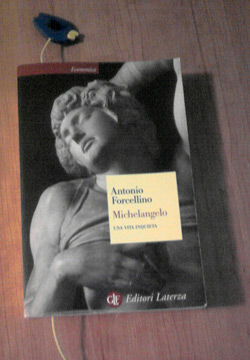The history of art, even and especially when it is presented without thatmysterious halo that marketing nowadays necessarily wants to assign to it in order to make it seem more appealing, always turns out to be a subject that is as fascinating as ever: proof of this is Michelangelo. An Unquiet Life, the biography of the great Renaissance artist written by Antonio Forcellino.
Before talking about the book, a few words about its author: Antonio Forcellino, a native of Campania, is a restorer (as well as an architect), comes from the Central Institute for Restoration in Rome and has supervised, among others, the restoration of the funeral monument of Julius II in San Pietro in Vincoli in Rome, a work by our Michelangelo. Antonio Forcellino has always been concerned with Michelangelo’s art, and although some of his latest attributions have raised the misgivings of art historians, his ability to tell the story of art is not in doubt.
 |
| Michelangelo.An Unquiet Life by Antonio Forcellino |
His Michelangelo. An Unquiet Life stands out because the reader will find, as he scrolls through its pages, the precision typical of the essay, and the involvement of the novel (although it is obviously not a fictional biography: there are no fanciful interventions, dialogues or anything else). One could say that it is a pure and simple biography, written, however, with a prose that captures and fascinates the reader and almost pushes him or her into the shoes of a contemporary observer of Michelangelo Buonarroti.
The book traces Michelangelo’s entire life, from childhood to 1564, the year of his death, and introduces the reader to all of the artist’s great masterpieces, but not only that: one of the peculiarities of Forcellino’s volume consists in his ability to contextualize the events of the artist’s life with those of the history of the 16th century. We will thus learn about the rise and fall of the Florentine Republic, the events that led to the election of popes such as Leo X or Clement VII, the political strategies of Julius II, as well as many of the tragic events that characterized the 16th century and that constitute indelible stains on the history of Italy, such as the sack of Rome and the lesser-known, but equally terrible and vicious, sack of Prato in 1512.
But above all, Forcellino lets us intoMichelangelo’s soul: helping himself with documents (primarily the letters Michelangelo wrote to his relatives, large excerpts of which the author quotes throughout the treatment/narrative), he attempts to reconstruct the difficult character of one of the most important sculptors in the history of art. What emerges is a portrait of a gloomy, miserly man, unable to enjoy the great riches accumulated during his years of hard work, and whose only reason for living seemed almost to be to redeem the prestige of his own family, the Buonarroti family, which Michelangelo wanted to bring back up the Florentine social ladder since it had touched, at the time of the great artist’s birth, one of the lowest points in its history, as Forcellino explains in the first pages of the book. We will thus find ourselves reading about the vicissitudes of a lonely and solitary man, full of problems and worries (such as that over the thorny affair of Julius II’s funeral monument, which for decades saw him engaged “against” the Della Rovere family, angry at the artist’s continual delays), and basically without any real friends, except for those of the Ecclesia Viterbiensis, the circle of intellectuals who wanted to reform the Church and who were composed of such personalities as Reginald Pole, Giovanni Morone, and especially Vittoria Colonna, a noblewoman and poetess as well as the person with whom Michelangelo found the greatest intellectual affinity. One cannot speak of love, because reading the book we see how the only love Michelangelo felt was towards people of the same sex, but who often reciprocated almost only out of mere interest.
And, returning to the Ecclesia Viterbiensis, Forcellino surpasses himself when he tells us about the frescoes of the Pauline Chapel, that is, the frescoes in which Michelangelo manifests, according to the author, the instances of the circle, accepted by the artist himself: it is one of the culminating and most interesting passages of the book, not least because it tells us about two of Michelangelo’s works (the Conversion of St. Paul and the Crucifixion of St. Peter) that are not well known by the general public, or at least are less well known than the frescoes of the nearby Sistine Chapel or the sculptures that have decreed Michelangelo’s worldwide fame (such as the Pieta or the David).
Michelangelo. An Unquiet Life is a book that will not disappoint art lovers, and it is a book that will help us discover that often, behind those masterpieces that we admire today with awe and involvement, lie stories of suffering and great tribulations. And, of course, it will help us discover sides of Michelangelo’s character that we would hardly imagine by looking at his works of art.After reading this book, we will thus be able to understand them better and understand them more deeply.
Michelangelo. An Unquiet Life
By Antonio Forcellino
Laterza, 2007
472 pages
14
Buy on Finestre Sull’Arte Books
Warning: the translation into English of the original Italian article was created using automatic tools. We undertake to review all articles, but we do not guarantee the total absence of inaccuracies in the translation due to the program. You can find the original by clicking on the ITA button. If you find any mistake,please contact us.